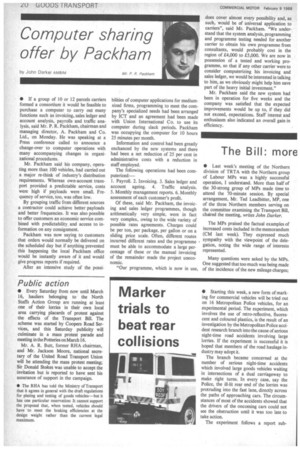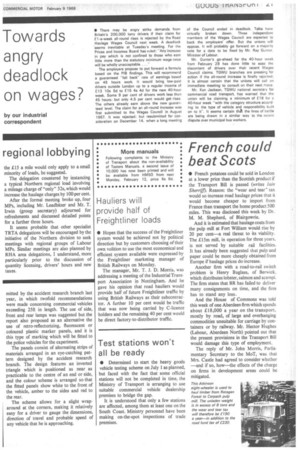Marker trials to beat rear collisions
Page 22

Page 23

If you've noticed an error in this article please click here to report it so we can fix it.
• Starting this week, a new form of marking for commercial vehicles will be tried out on 16 Metropolitan Police vehicles, for an experimental period. The experiment, which involves the use of retro-reflective, fluorescent and coloured plastics, is the result of an investigation by the Metropolitan Police accident research branch into the cause of serious night-time road accidents involving large lorries. If the experiment is successful it is hoped that members of the road haulage industry may adopt it.
The branch became concerned at the number of serious night-time accidents which involved large goods vehicles waiting in intersections of a dual carriageway to make right turns. In every case, say the Police, the ill-lit rear end of the lorries was protruding into the fast lane, directly across the paths of approaching cars. The circumstances of most of the accidents showed that the drivers of the oncoming cars could not see the obstruction until it was too late to take action.
The experiment follows a report sub
mitted by the accident research branch last year, in which twofold recommendations were made concerning commercial vehicles exceeding 25ft in length. The use of side, front and rear lamps was suggested but the report also proposed as an alternative the use of retro-reflectorizing, fluorescent or coloured plastic marker panels, and it is this type of marking which will be fitted to the police vehicles for the experiment.
The panels consist of alternating strips of materials arranged in an eye-catching pattern designed by the accident research branch. The design features an inverted triangle which is positioned as near as practicable to the centre of an end or side, and the colour scheme is arranged so that the fitted panels show white to the front of the vehicle, amber to the sides and red to the rear.
The scheme allows for a slight wraparound at the corners, making it relatively easy for a driver to gauge the dimensions, direction of travel and probable speed of any vehicle that he is approaching.




































































































